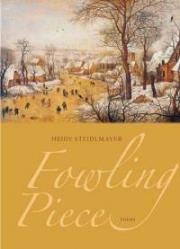
Fowling Piece
by Heidy Steidlmayer
TriQuarterly Books, Northwestern University Press
The poems in Heidy Steidlmayer’s Fowling Piece revel in edges and borders. Their speakers are situated at boundaries between isolation and independence, between mourning and companionship, between illness and wellness. Much like the knives (and skate blades, tides, x-rays, and magnetic resonance imaging) that appear in her work, her poems rely on edges to create, shape, and explore divisions in our experience. And yet easy binaries, however convenient, don’t fully attest to the power at work in her poems. A border between the countries of “absence” and “presence” might suggest a black-and-white dichotomy, but Steidlmayer renders mourning as a rich and shifting intermediary state that both contrasts and conjoins the realms of presence and loss. Her lyrics, simultaneously opaque and inviting, communicate layers of complexity and range as they wield an inspired attention to events, conditions, and language.
The title suggests range in multiple ways—a “fowling piece” is an archaic name for a shotgun; shooting with buckshot suggests a technique not as laserlike as direct aim, as one needs merely to fire in the direction of a target and the nature of one’s ammunition will naturally expand its range and narrow the gap between subject and object. The title also generates homophonic echoes—“fowl” resonates with “foul”; “piece” denotes parts and fragments in relation to a whole and also yields “peace.” Here’s the title poem, one as lovely and loaded as Emily Dickinson’s:
The pull of guns I understand,
my father taught me hand on hand
how death is. Life asserts.
(Best take it like a man.)
I shot a dove, the common sort
and mourned not life but life so short
that gazed from death as if unhurt.
And I had nothing to report.
Its iambic music and spondaic interruptions, its taut play with both line and sentence sense (I love the enjambment between lines 2 and 3 in both stanzas), and the aural and figurative resonance of its last word, “report,” all generate the expansive economy of effective lyrical work. The poem extends into gendered familial relationships and beyond, asking questions and exploring ultimate boundaries between life and death.
Both “Fowling Piece” and the collection’s initial poem, “I Say So Long to the Hedge Rider,” nicely introduce Steidlmayer’s liminal concerns and settings. Hedge riding—a spirit-flight into other realms (perhaps an underworld visit with the dead or a more astral summit with gods), a straddling of borders between worlds or planes—can also refer to a holistic form of medicine, one more arcane and mysterious than allopathy. And in the poem’s first sentence, a dynamic six lines, the speaker straddles boundaries between old and new worlds and between the theoretical and the actual.
Hey, edge stepper carrying your bag
of quicklime and larks, I thought you’d gone,
hitched your sad self to some old words
like hither and ell, but here you come
tramping through the half-light of the forest
like an idea that is only good on paper.
(“I Say So Long to the Hedge Rider”)
In language that wonderfully combines poetic measure (lines that range from 4 to 5 beats and 8 to 10 syllable lines) and colloquial tone, we hear a speaker’s ready acknowledgment of differing selves: this edge stepper is a ghost of oneself being sent away. It’s a heady and strong introduction to a voice that will challenge other realms and characters. I love the medieval diction of “quicklime and larks” that flirts with contemporary colloquialisms like “hitched” and “tramping” and even a casual vocative (“Hey”). Steidlmayer’s images and figuration lend further layers to an already rich poem that brings to bear both doubt and confidence as it questions how one might move beyond inherited positions and old prescriptions. Similar concerns with thresholds emerge in poems such as “Oracle,” “Talking with the Dead,” and “Charon Reconsiders.”
Steidlmayer has a number of poems that feature sharp figurative work, such as “Poverty,” where the sun “beat[s] down” and “brings another day to its knees,” and “Interpreting the Films,” which presents the brain “with its wads / of flat batting and weird yarn.” She also creates compelling figurative collages that craft whole poems out of discrete, isolate shapes. “Figures” weds the literal and the trope to great effect, elliptically linking wonder at an Orrery, a woman ironing creases out of shirts and dreaming of ice skating, and a taut, whimsically sharp reflection on turnstiles and how “a man halved / from the hips down turns / out fine. He still feels . . .”
Along with range and reach, Steidlmayer’s lyrics yield a lush precision in diction and musical effect. Her language recalls Plath’s deft vowel play and Hopkins’s dense consonantal-and-vowel stews:
Sad amplitudes of clocky junk
crank moons and tiny globes of granite.
(“Figures”)
greenest of winter trees; gallows; bent bow;
brittle iron; giant of the arrow . . .
(“Divination by Runes”)
nor the squat tug
lugging its ugly embargo—
but the fat beached fish
repeating bad tidings
(Riptide)
Steidlmayer’s eye and attention also bring to mind Marianne Moore, although if Steidlmayer ever falls short she does so in a few poems that emulate Moore’s natural history lexicons. A poem like “The Stentor,” however, dazzles in its balance of lexicon and sound and figure, where a synesthetic mix of vision and sound combine with associative leaps to generate a complex and ambitious poem.
Of special note in this collection are its latter poems, many of which explore realms of medicine and illness and mothering with a deft touch. “Resonance,” “Riptide,” “The Scan,” and “Delivery” are particularly strong.
I read that they dragged you
from the dark like a sea creature
and set you among babies
missing things like yourself—
kidneys or a piece of heart—
and that you flourished
without me.
(“Delivery”)
These poems conclude an impressive arc from the collection’s initial foray into healing to lyrics with modern medicine front and center. And the collection concludes wonderfully: her last poems, “Scylla” and “Charybdis,” serve as a formally varied coda for liminal explorations beyond the borders of the physical body. As music that lingers, a siren call to attention, her lyrics travel a familiar Odyssean gauntlet that christens language as an essential vessel—one we ride, and one in which we set beloveds adrift to navigate on their own.


